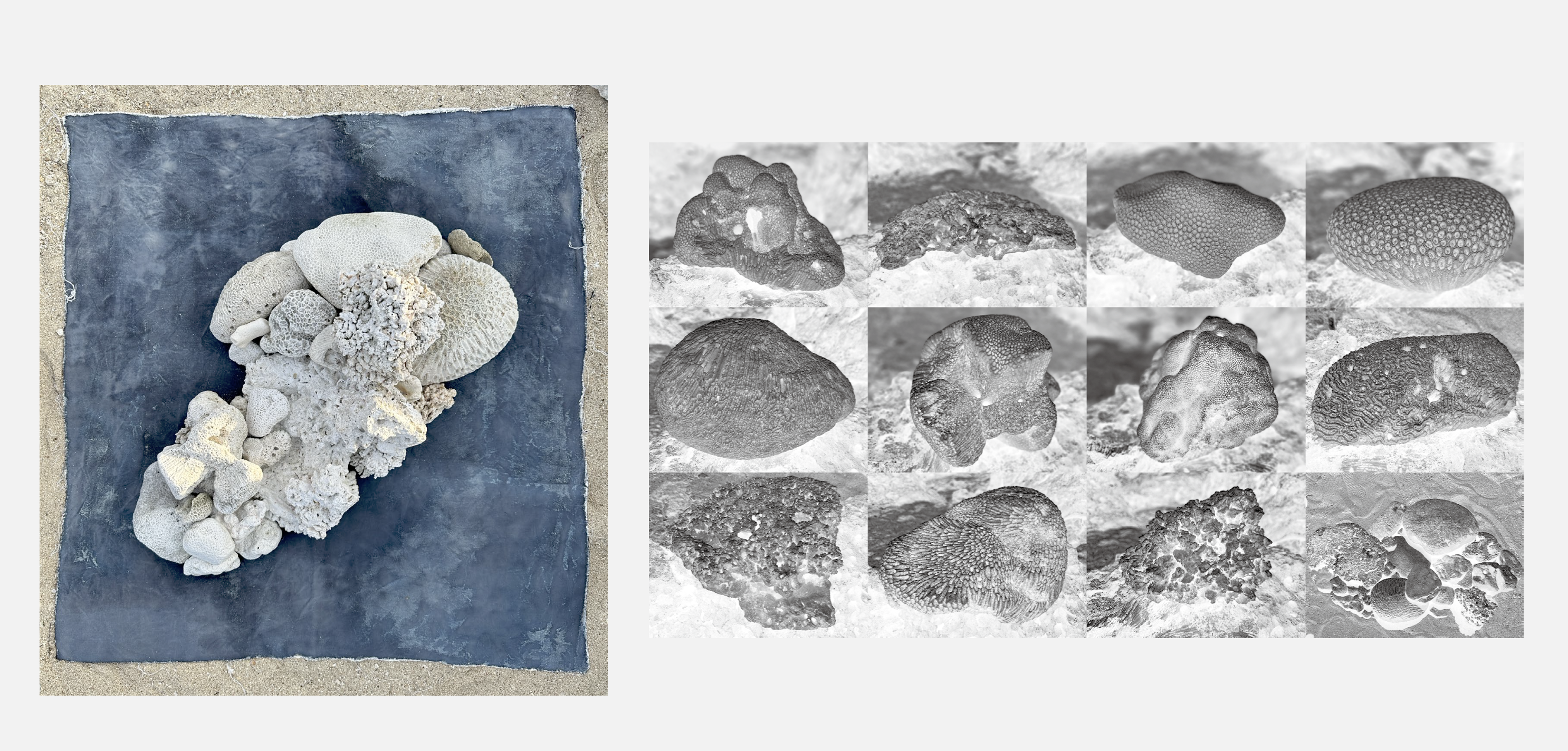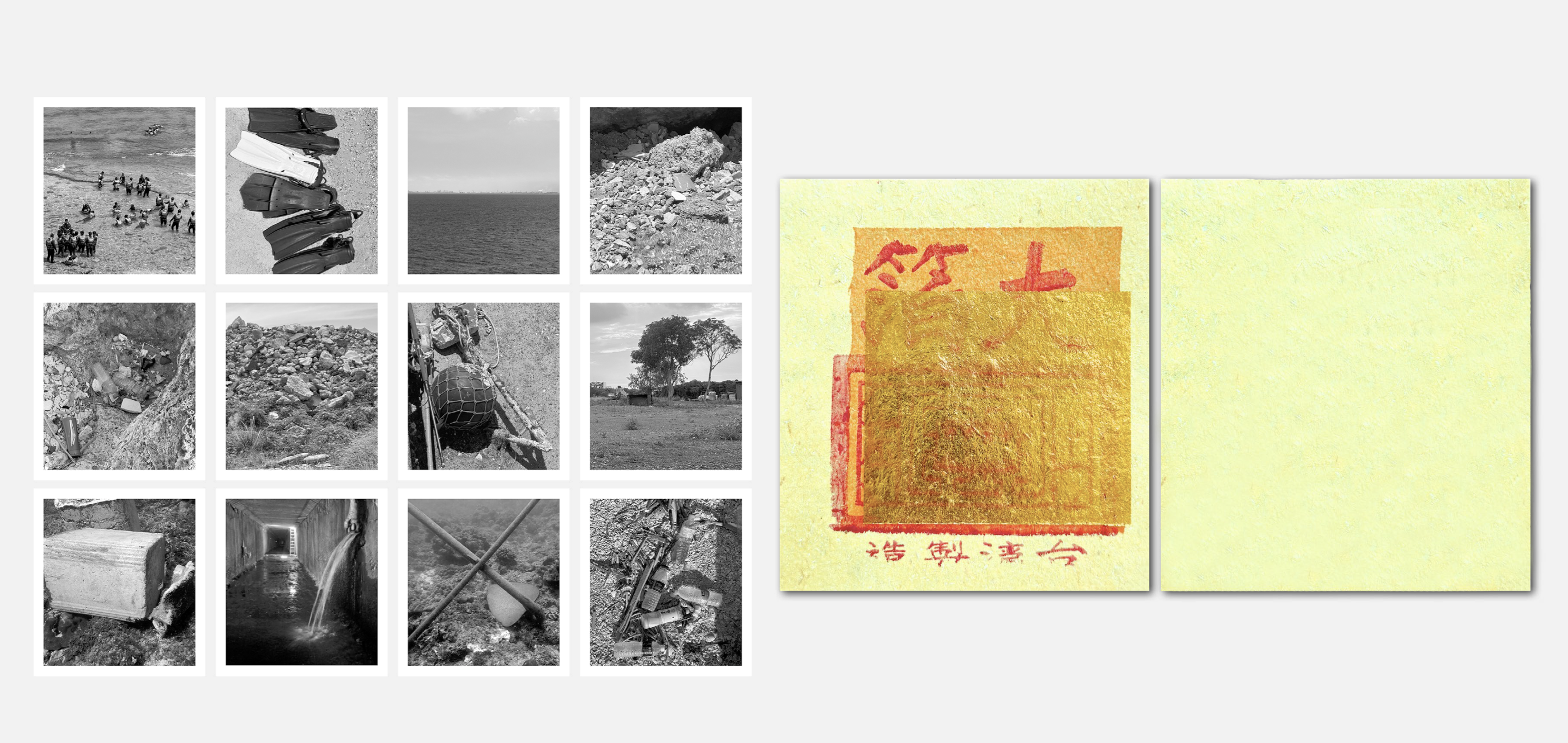在他者出生之地,談論自身死亡
In the Birthplaces of Others, Discussing Our Own Deaths
2023Cyanotype on cotton cloth 75x75cm
Photograph, digital print on paper 12.2x13.4cm



2023年5月,時隔了十年我再度踏上小琉球,我留意到小琉球的旅遊廣告和遊客往往把注意力集中在海龜身上,我也受此影響,當我目睹海龜在海面上自由遊動時,也對小琉球的生態環境感到喜悅與興奮。然而,透過深入的研究與調查,我發現這是一種誤解。珊瑚能提供一個環境供其他生物棲息,進而豐富生態系統的多樣性。因此,真正評估生態系統健康的指標應是珊瑚的覆蓋率。不幸的是,小琉球作為台灣唯一的珊瑚礁島嶼,卻受到人類開發、氣候變化和觀光旅遊等多重因素的影響,導致島嶼周圍珊瑚的覆蓋率不足10%,生態結構與功能也遭受了嚴重的損失。
《在他者出生之地,談論自身死亡》是一件結合兩個部分的藝術作品,旨在呈現自然中的矛盾與誤解,以及我個人對此的回應。首先,我運用藍曬的特性,利用在沙灘上找到的珊瑚外骨骼構成的珊瑚石作為底層。透過拼湊這些珊瑚石,形成了小琉球島嶼的輪廓,同時藉著藍曬喚起我對小琉球及其周圍珊瑚白化死亡的思索和聯想。其次,我走訪小琉球的海岸線,拍攝各種影響珊瑚生長的因素並蒐集相關新聞圖像。將這些影像印製在金紙上,並將它們放置在藍曬地圖上相對應的位置。這樣的呈現是我試圖透過與神明和自然界的對話,祈求減緩珊瑚消逝的速度。最後,我將藍曬作品和金紙放置在形似海龜築巢的沙坑上,期待著將人們的關注從海龜的保育轉向珊瑚的死亡議題。
In May of 2023, a full decade after my last visit, I once more set foot on the island of Xiaoliuqiu. I could not help but notice how advertisements for tourism on Xiaoliuqiu as well as the tourists themselves focused all their attention on sea turtles. I didn’t escape this influence, either. When I laid my eyes on a sea turtle swimming freely on the water’s surface, I felt joyous excitement for Xiaoliuqiu’s ecosystem well up within me. However, a thorough exploration of the issues involved led me to realize that my excitement was born of misunderstanding. Coral is capable of providing a habitat for other lifeforms, and by extension to add to the richness and diversity in an ecosystem. For this reason, the real way in which to assess the health of the Xiaoliuqiu’s marine ecosystem should be its degree of coral reef coverage. Unfortunately, Taiwan’s one and only coral island—Xiaoliuqiu—has been impacted by overlapping factors including extractionist human activity, tourism, and climate change. As a result, the level of coral reef coverage in the island’s vicinity is less than 10 percent. The local ecosystem has suffered serious losses, both structurally and functionally.
“In the Birthplaces of Others, Discussing Our Own Deaths” is an artwork that merges two disparate elements, with the intent of illuminating some of the conflicts and misunderstandings inherent in humanity’s role in the natural world, while also presenting my own reactions to these issues. I began by taking advantage of the unique characteristics of cyanotypes, using fossilized pieces of corals’ skeletal forms to create a base layer. I arranged this layer of fossilized corals in the shape of Xiaoliuqiu, using the cyanotype process to create a photogram that evokes my thoughts on Xiaoliuiqiu, coral bleaching, and coral reef die-offs. Next, I explored Xiaoliuqiu’s coastline first hand, photographing various factors affecting coral’s growth and development; at the same time, I gathered related images from the news media. I printed these images on joss paper (also known as “ghost money” or “ancestor money”), and then arranged them on the cyanotype photogram in their corresponding locations around Xiaoliuqiu. This approach displays my attempt to pray for a slowing of the pace of coral reef die-offs by creating a dialogue between divine spirits and the natural world. Finally, I placed the cyanotype and the photographs printed on joss paper into a sandbox in which I created a model sea turtle nest. My aspiration is that this installation will draw people’s attention from protecting sea turtles towards protecting the entire coral reef environment.




